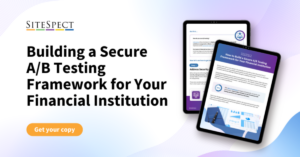Components to A/B Test in Your E-commerce Checkout
By Kevin Plankey
April 12, 2023
Share
It can be difficult to identify and prioritize which components should be A/B tested to best help reach your established KPIs and business goals. Fortunately, good discipline around experimentation can help with e-commerce optimization and can be a continuous process that ensures you are constantly improving the overall shopper experience.
Below are some A/B testing ideas you should consider, but before you get started, make sure you have a clear set of goals as well as analytics in place so you can measure the impact of each test. Also, keep in mind, you won’t want to A/B test everything at once, as this may inhibit your ability to tell what change is creating the impact.
Product Placement
Use the real estate on your homepage to run tests that feature new arrivals, discounted products, best-selling items, or seasonal items. Another interesting test would be to experiment with product placement organized by price. By anchoring higher priced items up front, your mid-level products are perceived as more affordable and attractive to your shoppers.
Product Images
There is a multitude of things that you can A/B test on your product detail pages, from images to delivery options and everything in between, and you should test everything.
Product images are crucial because you want the product item to stand out as much as possible. So, some things to test would be:
- Showing the product in use with video versus just an image on a plain background.
- Showing the product using different angles and letting shoppers zoom in and get a better idea of what the product looks like.
- If you’re showing multiple images for each product, test the order in which those images are shown.
Product Description
The goal of product descriptions is to give shoppers enough information to help them determine if it’s the right product for them.
Play around with the copy and try adding a personal touch to each description and see whether the formal or less formal version performs better. Another testing option would be short vs. long descriptions. This is a way to determine how much investment is worth putting into long descriptions.
One way to do it is to run a pilot by focusing on a specific category and test short vs. long descriptions there first. Then based on the results, roll out the test to more categories.
In addition, pay attention to how all these details are displayed and in what order. Try testing drop-down tabs or even content on hover so you don’t crowd the product page with too much information. Sometimes it’s about how the information is presented rather than by the information itself.
Product Ratings & Reviews
Like it or not, people adapt their behaviors based on what others do. The greater the number of reviews, and the more positive, the more likely you’ll convince shoppers to make the purchase. So, experiment here by either choosing to display them or not, test their location as well as how they are displayed, and even the order of the reviews. This can help inform budgeting decisions for investing in 3rd party review tools.
Call-to-Action
It seems there are lots of opinions on what CTA buttons should look like and say, but the best way to see if they work for your shoppers is to A/B test them. When it comes to the copy, it should always be clear what happens upon clicking the button.
Apart from the copy, you can experiment with the size, color, and placement. When it comes to placement, however, the simpler and more visible your CTA is, the better – don’t hide it. Your mileage may vary, however, so don’t get too hung up on CTA testing if you are not seeing them move the needle.
Checkout Process
There are several ways you can test your checkout process, including putting everything on one page or spreading the process out over multiple steps. It really comes down to the number of steps your shoppers are willing to take, but the key here is to reduce friction as much as possible.
If your checkout page has a high bounce rate and/or a low conversion rate, try A/B testing a multi-step checkout process against a single page one or vice versa, depending on what you have today. You can also try simplifying the design to see if this affects conversions. Other testing options include removing irrelevant fields and removing unnecessary elements.
Guest vs. Registered User
If you currently require shoppers to register before they can buy anything you might consider providing the option to purchase as a guest to potentially capture one-time buyers. And if you’re in favor of still requiring shoppers to register, you can experiment with more options such as signing up with Google or a social media account. Both solutions have the potential to speed up your checkout process and thereby increase conversions.
Remember, don’t make the checkout process harder than it needs to be!
Address Forms
If you have a form with many required fields, you may be driving shoppers away. Try reducing the number of fields or making some of them optional. A/B test the number of fields to see if your shoppers are more willing to complete it if there are fewer fields. It’s good to keep things focused on the purchase and avoid asking for any unnecessary information.
You could try using a single field for the customer’s full name rather than separate fields for their first and last name. In addition, run a test that automatically makes the shipping address the same as the billing address, but be sure to give the shopper the ability to change that.
While you are at it, track and monitor errors that occur on critical forms, and A/B test solutions to reduce error rates. Check out 6 Hypotheses to Test on Your Online Forms for additional tips on optimizing your forms.
Shipping Delivery
One of the easiest ways to find out how your shoppers feel about shipping is to A/B test your delivery options. You can test displaying different delivery options, such as pick-up in-store, ship-to-home, or ship-to-store. You can also try displaying them in a different order. Another viable test would be to display delivery options based on the arrival date, which can make some delivery methods more popular than others.
In addition, you can experiment with a free shipping option. The hypothesis is that free delivery offers would entice shoppers to add more to their cart, thus raising the average order value. Finding the right threshold for when free shipping applies is a great opportunity for A/B testing. Make sure to understand your costs and margins when compiling results from these experiments.
Payment Options
Like choosing a delivery option, shoppers like having a choice when it comes to paying for their purchases. Apart from standard payment methods like credit and debit cards, you can test other payment options, such as PayPal or Apple Pay.
In addition to A/B testing different payment options, you can also test when and how you feature and display these payment options during the checkout process, as well as give your shoppers the ability to save payment information for future purchases.
Adding easy-to-use payment methods and simplifying the checkout payment process is always a good idea.
Final Thoughts
- Don’t jump to conclusions too quickly. Be patient and put your gut feelings aside.
- Run the experiments for a longer period to validate the test results, if necessary.
- On the flip side, know when to call it quits when an experiment is not moving the needle.
- Understanding what part of the user experience impacts your bottom line is a big part of the process.
- There are no losers, just learnings. Dig into underperforming experiments and iterate on your ideas.
- Don’t stop optimizing. Checkout optimization is a never-ending process. So repeat tests to validate that seasons and external events weren’t the cause of a winning or losing variation.
Speak with an experimentation expert to learn more about identifying and prioritizing the best components to test and see a demo. It will be time well spent!
Share
Suggested Posts
Subscribe to our blog:





